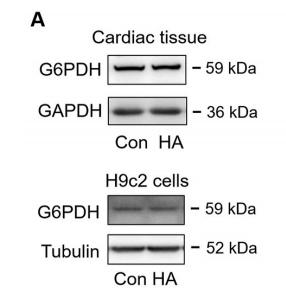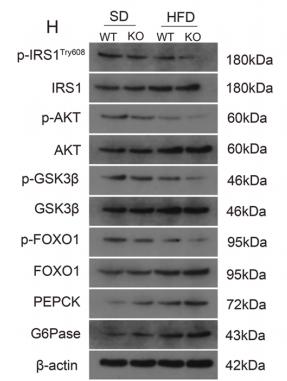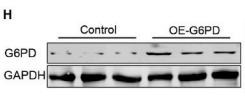G6PD Antibody - #DF6444
製品説明
*The optimal dilutions should be determined by the end user. For optimal experimental results, antibody reuse is not recommended.
*Tips:
WB: For western blot detection of denatured protein samples. IHC: For immunohistochemical detection of paraffin sections (IHC-p) or frozen sections (IHC-f) of tissue samples. IF/ICC: For immunofluorescence detection of cell samples. ELISA(peptide): For ELISA detection of antigenic peptide.
引用形式: Affinity Biosciences Cat# DF6444, RRID:AB_2838407.
折りたたみ/展開
G6PD; G6PD_HUMAN; G6PD1; G6pdx; Glucose 6 phosphate 1 dehydrogenase; Glucose 6 phosphate dehydrogenase; Glucose 6 phosphate dehydrogenase, G6PD; Glucose-6-phosphate 1-dehydrogenase; MET19; POS10; Zwf1p;
免疫原
A synthesized peptide derived from human G6PD, corresponding to a region within the internal amino acids.
- P11413 G6PD_HUMAN:
- Protein BLAST With
- NCBI/
- ExPASy/
- Uniprot
MAEQVALSRTQVCGILREELFQGDAFHQSDTHIFIIMGASGDLAKKKIYPTIWWLFRDGLLPENTFIVGYARSRLTVADIRKQSEPFFKATPEEKLKLEDFFARNSYVAGQYDDAASYQRLNSHMNALHLGSQANRLFYLALPPTVYEAVTKNIHESCMSQIGWNRIIVEKPFGRDLQSSDRLSNHISSLFREDQIYRIDHYLGKEMVQNLMVLRFANRIFGPIWNRDNIACVILTFKEPFGTEGRGGYFDEFGIIRDVMQNHLLQMLCLVAMEKPASTNSDDVRDEKVKVLKCISEVQANNVVLGQYVGNPDGEGEATKGYLDDPTVPRGSTTATFAAVVLYVENERWDGVPFILRCGKALNERKAEVRLQFHDVAGDIFHQQCKRNELVIRVQPNEAVYTKMMTKKPGMFFNPEESELDLTYGNRYKNVKLPDAYERLILDVFCGSQMHFVRSDELREAWRIFTPLLHQIELEKPKPIPYIYGSRGPTEADELMKRVGFQYEGTYKWVNPHKL
種類予測
Score>80(red) has high confidence and is suggested to be used for WB detection. *The prediction model is mainly based on the alignment of immunogen sequences, the results are for reference only, not as the basis of quality assurance.
High(score>80) Medium(80>score>50) Low(score<50) No confidence
研究背景
Cytosolic glucose-6-phosphate dehydrogenase that catalyzes the first and rate-limiting step of the oxidative branch within the pentose phosphate pathway/shunt, an alternative route to glycolysis for the dissimilation of carbohydrates and a major source of reducing power and metabolic intermediates for fatty acid and nucleic acid biosynthetic processes.
Acetylated by ELP3 at Lys-403; acetylation inhibits its homodimerization and enzyme activity. Deacetylated by SIRT2 at Lys-403; deacetylation stimulates its enzyme activity.
Cytoplasm>Cytosol. Membrane>Peripheral membrane protein.
Isoform Long is found in lymphoblasts, granulocytes and sperm.
Belongs to the glucose-6-phosphate dehydrogenase family.
研究領域
· Human Diseases > Cancers: Overview > Central carbon metabolism in cancer. (View pathway)
· Metabolism > Carbohydrate metabolism > Pentose phosphate pathway.
· Metabolism > Metabolism of other amino acids > Glutathione metabolism.
· Metabolism > Global and overview maps > Metabolic pathways.
· Metabolism > Global and overview maps > Carbon metabolism.
参考文献
Application: WB Species: rat Sample: cardiac tissues and H9c2 cells
Application: WB Species: mouse Sample: liver
Application: WB Species: Human Sample: HepG2 cells
Restrictive clause
Affinity Biosciences tests all products strictly. Citations are provided as a resource for additional applications that have not been validated by Affinity Biosciences. Please choose the appropriate format for each application and consult Materials and Methods sections for additional details about the use of any product in these publications.
For Research Use Only.
Not for use in diagnostic or therapeutic procedures. Not for resale. Not for distribution without written consent. Affinity Biosciences will not be held responsible for patent infringement or other violations that may occur with the use of our products. Affinity Biosciences, Affinity Biosciences Logo and all other trademarks are the property of Affinity Biosciences LTD.







